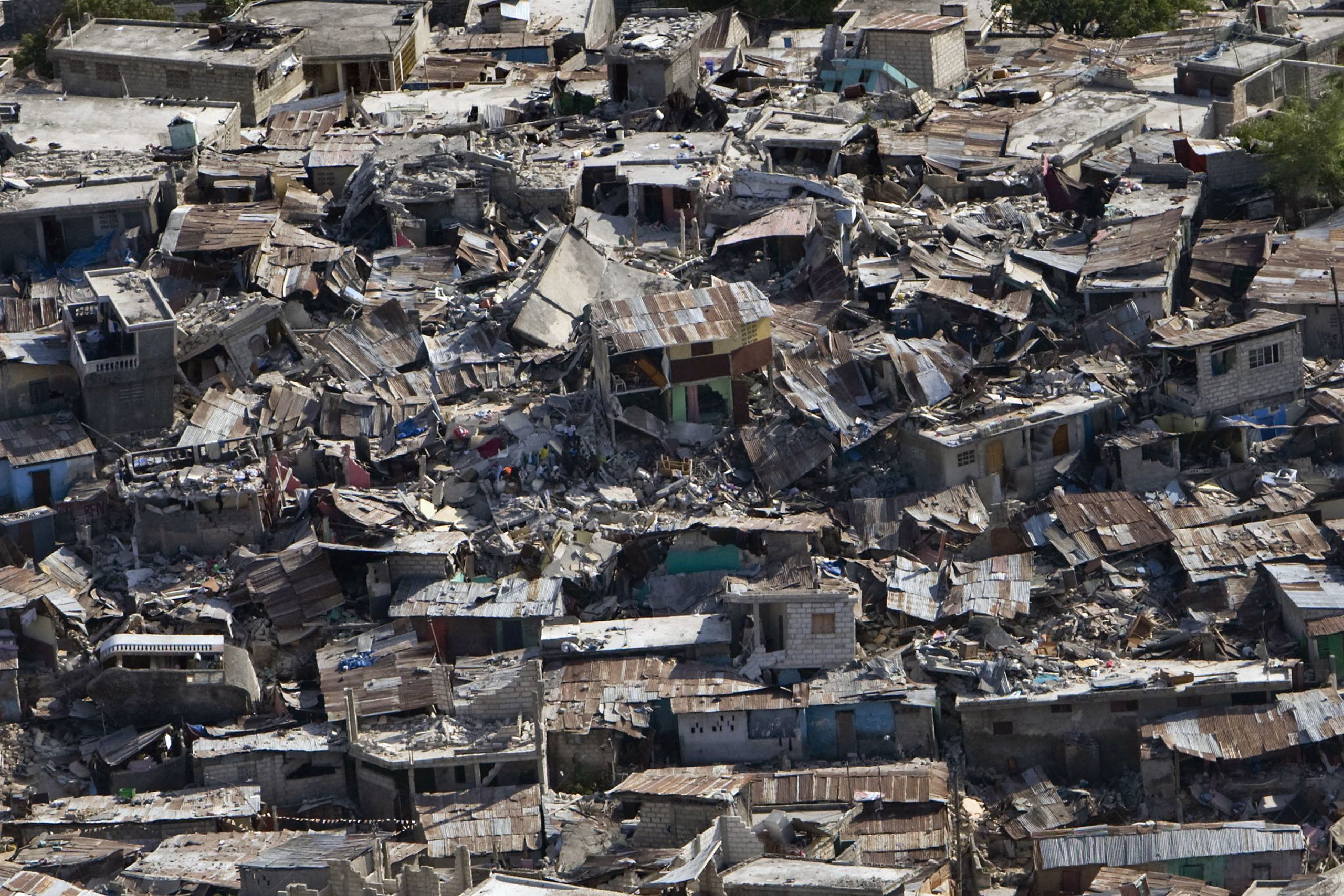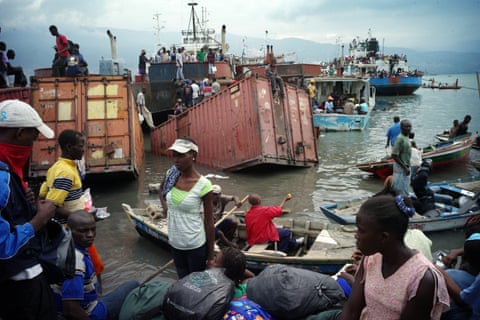Join Date: Feb 2011
Posts: 47,660
Thanks: 27,646
Thanked 14,458 Times in 10,262 Posts
|
 Re: Haiti Earthquake; Failed Promise of Aid-Americans Donated $MILS -Haiti Received 1
Re: Haiti Earthquake; Failed Promise of Aid-Americans Donated $MILS -Haiti Received 1
Haiti and The Failed Promise of US Aid After Earthquake in 2010.
Haiti Earthquake; Failed Promise of US Aid -Americans Donated $MILS Through The Red Cross -Haiti Only Received 1% to Help Rebuild The Caribbean Country.
More than a decade later, nothing better symbolises the failure of these efforts than the story of a new port that was promised, but never built
The Guardian 16 MAR 2024
 Over their many decades of involvement there, the Clintons became two of the leading proponents of a particular approach to improving Haiti’s fortunes, one that relies on making the country an attractive place for multinational companies to do business.
Over their many decades of involvement there, the Clintons became two of the leading proponents of a particular approach to improving Haiti’s fortunes, one that relies on making the country an attractive place for multinational companies to do business.
They have done this by combining foreign aid with diplomacy, attracting foreign financing to build factories, roads and other infrastructure that, in many cases, Haitian taxpayers must repay. Hillary has called this “economic statecraft”; others have called it a “neoliberal” approach to aid.
The most significant test of this approach in Haiti began on 12 January 2010, when a magnitude 7.0 earthquake struck just west of the capital, Port-au-Prince. In a nation of 10 million people, 1.6 million were displaced by the disaster, and as many as 316,000 are estimated to have died. The earthquake also dealt a huge blow to Haiti’s economic development, levelling homes and businesses in the most populous area of the country and destroying crucial infrastructure, including the nation’s biggest port.
Within days of the earthquake, the Clintons stepped up to lead the global response. Bill was selected to co-chair the commission tasked with directing relief spending. As US secretary of state, Hillary helped to oversee $4.4bn that Congress had earmarked for recovery efforts by the US Agency for International Development, or USAid. “At every stage of Haiti’s reconstruction – fundraising, oversight and allocation – a Clinton was now involved,” Jonathan Katz, a journalist who has covered Haiti for more than a decade, wrote in 2015.
There was no greater embodiment of the neoliberal approach to aid in Haiti than the US’s largest post-earthquake project – a $300m, 600-acre industrial park called Caracol, on the country’s northern coast. To make the park more attractive, the US also agreed to finance a power plant, and a new port through which firms operating at Caracol could ship in materials such as cotton, and ship out finished products including T-shirts and jeans.
The Clintons and their allies believed the Caracol project would attract international manufacturers, which they saw as the primary fix to Haiti’s faltering economy. “Haiti has failed, failed and failed again,” wrote the British economist Paul Collier and his colleague Jean-Louis Warnholz, who have both advised the Clintons, in the Financial Times two weeks after the earthquake. By building “critical assets such as ports”, they argued, the US and its allies could help Haiti attract private, foreign investment and create the stable jobs it needed to prosper.
Ten years later, the industrial park is widely considered to have failed to deliver the economic transformation the Clintons promised. But less attention has been paid to the fate of the port. Last year, after sinking tens of millions of dollars into the port project, the US quietly abandoned it.
The port is now one of the final failures in an American post-earthquake plan for Haiti that has been characterised by disappointment throughout. It is also the latest in a long line of supposed solutions to Haiti’s woes that have done little –
or worse – to serve the country’s interests.
“The neoliberal, exploitative economic model currently being imposed” on Haiti “has failed many times before,” Antony Loewenstein, author of Disaster Capitalism: Making a Killing Out of Catastrophe, has written. The result, he adds, is that many Haitians are living “in a state of despair and daily desperation”.
Haiti makes up the western third of the island of Hispaniola – the other two-thirds are the Dominican Republic – situated between the Atlantic and the Caribbean along several major international shipping lanes. “It’s a strategic location,” says Claude Lamothe, the former director of a small port in the northern city of Cap-Haïtien. “All the big boats from the US pass right by here.”
For decades, the vast majority of goods coming to or leaving Haiti travelled through the ageing port at Port-au-Prince in the south. In the 70s, that port handled 90% of Haiti’s imports and 60% of its exports (including thousands of baseballs destined for the US, some for the Major League). But by the late 2000s, the fees it charged companies to dock, load and offload their goods were higher than any other port in the region. So companies turned to ports in the Dominican Republic, Cuba, the Bahamas or Trinidad and Tobago instead.
When the earthquake hit, a large section of the port at Port-au-Prince collapsed into the sea. “The damage was unbelievable,” said Russell Green, a civil engineer at Virginia Tech University, who arrived to survey the port a few weeks after the disaster.
Just before the earthquake hit, Paul Collier had published a report for the UN that laid out a vision for Haiti in which international manufacturing and trade would create hundreds of thousands of jobs in a few short years and drive the country’s economy into the future.
His plan was a particularly clear expression of the neoliberal prescription for aid: reduce taxes on businesses to attract foreign investment, reduce tariffs to make it cheaper to buy and sell goods and offer loans to finance the infrastructure necessary to accommodate the rest. All this would create jobs, and these new wage-earners would then spend their money on goods from abroad.
Everybody, in theory, would win.
International trade has dictated Haiti’s economy almost since Christopher Columbus landed on Hispaniola by mistake, in 1492. After Spain and later France colonised the island, they imported African slaves to produce one of the most lucrative commodities in history – sugar – and exported it around the globe. By the eve of Haiti’s independence, which Haitians won in 1804, global trade had made the country one of the most profitable pieces of land in the world.
But all this international commerce has rarely benefited the vast majority of Haitians. Little of the wealth generated in the country has ever stayed there. For almost its entire history, Haiti has owed a trade debt to other nations – most notably, a $21bn (in today’s money) burden levied by France after independence. During the two centuries that followed, the effect of these debts has been to severely impoverish the country, and to make it beholden to the rich nations who have acted as its creditors.




By the time the earthquake struck, in 2010, a nation that in the 70s grew enough rice to feed itself was now importing 80% of it from abroad.
“Artibonite used to be rich, but now it’s poor,” Denis Jesu-car, a rice farmer in one of Haiti’s most agriculturally rich regions, once explained to me. “We produce rice, but it doesn’t sell.”
Looking back at the 2010 Haiti earthquake a decade later
Has The World Failed Haiti?
|